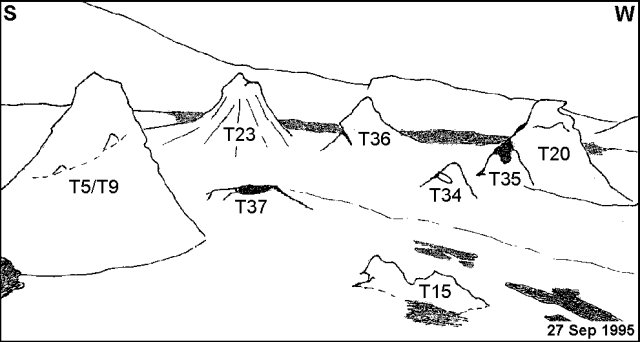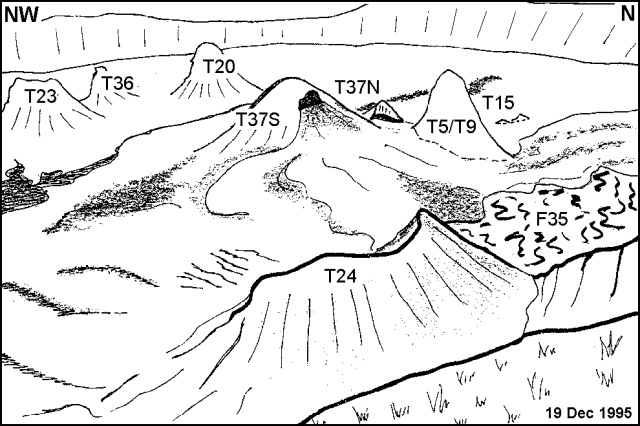Report on Ol Doinyo Lengai (Tanzania) — June 1996
Bulletin of the Global Volcanism Network, vol. 21, no. 6 (June 1996)
Managing Editor: Richard Wunderman.
Ol Doinyo Lengai (Tanzania) Summary of activity July 1995-April 1996
Please cite this report as:
Global Volcanism Program, 1996. Report on Ol Doinyo Lengai (Tanzania) (Wunderman, R., ed.). Bulletin of the Global Volcanism Network, 21:6. Smithsonian Institution. https://doi.org/10.5479/si.GVP.BGVN199606-222120
Ol Doinyo Lengai
Tanzania
2.764°S, 35.914°E; summit elev. 2962 m
All times are local (unless otherwise noted)
The following report summarizes morphological changes in the summit crater seen in a series of visits between July 1995 and April 1996 (figures 38-41).
On 19 July 1995 a group of cones observed W of T5/T9 included T23, T20, T36, T35 (a small cone joined to the SE side of T20), and T34 (BGVN 20:10). The upper parts of T8, T14, and T15 were engulfed by younger flows. T37, a low mound at the base of the NW slope of T5/T9, was not active. Lavas escaped from small vents at the base of T36. At the same time two hornitos in the T36 cluster were emitting low sprays of gassy lava. Lava, coming probably from T23 and T36, had almost filled the depression W of T5/T9 described by Dawson in late 1993 (BGVN 17:10).
On 27 September 1995, Andy Johnson observed a slight growth of T37, which remained a broad open feature, 1.5 m tall (figure 38). T36 showed a more pointed summit, but it hadn't changed significantly. There was no other sign of activity. A visit on 17 October 1995 by Jorg Keller revealed that T37 had grown into a broad cone to half the height of T5/T9. Small clots of lava were erupted S of T37 (at T37S). T37S soon became taller that the rest of the cone.
 |
Figure 38. Ol Doinyo Lengai crater looking SW across the crater floor, 27 September 1995. Sketched by C. Nyamweru from a photo by A. Johnson. |
Burra Ami Gadiye visited on 21 November 1995 and noted no drastic change for T37, but reported that the N and S parts were distinguishable. T37S was clearly higher and darker than the N part, with fresh lava on its W slope. Activity was observed from a vent on T36 (figure 39). On 1 December 1995, Gadiye reported that continued growth of T37 had resulted in a large cone (T37S) and an open vent on a low dome (T37N). Lava flowing copiously and rapidly N traveled past T15. The source, located W of T5/T9, was probably at the base of T37S.
During a 15-19 December 1995 visit, C. Oppenheimer and P. Vetsch observed emission of small amounts of carbonatitic lava coming from the cone cluster T36 (BGVN 20:11/12). On 18 December the E-flank of T37S collapsed followed by a NE-directed lava flow that covered a large part of the F35 flow and surrounded the E slope of T5/T9. Continued activity at T37S built a large cone with a vent high on its SE slope (figure 40). T37N remained small and formed a partial cone on the W side of an open vent.
 |
Figure 39. Ol Doinyo Lengai crater looking E across the crater floor, 21 November 1995. Sketched by C. Nyamweru from a photo by B.A. Gadiye. |
 |
Figure 40. Ol Doinyo Lengai crater looking NNW from SE rim, 19 December 1995. Sketched by C. Nyamweru from a photo by B.A. Gadiye. |
On 20 December Iris Saxer saw that the vent on the SE slope of T37S had been filled with lava and built a rim of spatter on its lip. This cone became almost as high as T5/T9 but much broader. A small summit vent was observed emitting puffs of steam and occasional clots of lava.
On 18 January 1996, H. Schabel observed small amounts of pahoehoe lava flowing N from vents near the base of T37S; the lavas surrounded T15. Few changes were noted in the shape of T37S but lava still spattered from its summit vent.
On 8 February, B. Saunders found that the top of T37S had collapsed (figure 41). Several flows originating from T37 had gone N and NE to reach the base of the crater wall. Some of these flows had crossed F35, around the E side of T5/T9. Other flows had reached farther E to separate F35 from the base of the E crater wall. Bubbling lava issued from a small vent at the SE base of T37S.
 |
Figure 41. Ol Doinyo Lengai crater looking SW from the E rim, 8 February 1996. Sketched by C. Nyamweru from a photo by B. Saunders. |
During 4-6 April, J.M. Bardintzeff observed a lava platform on the E side of T37S and a lava lake with asymmetrical overhang facing W. At that time lava was escaping the lake to the S and SW. Saunders also noted that a vent on the W side of the T36 cluster was a source of intermittent lava spattering.
Geological Summary. The symmetrical Ol Doinyo Lengai is the only volcano known to have erupted carbonatite tephras and lavas in historical time. The prominent stratovolcano, known to the Maasai as "The Mountain of God," rises abruptly above the broad plain south of Lake Natron in the Gregory Rift Valley. The cone-building stage ended about 15,000 years ago and was followed by periodic ejection of natrocarbonatitic and nephelinite tephra during the Holocene. Historical eruptions have consisted of smaller tephra ejections and emission of numerous natrocarbonatitic lava flows on the floor of the summit crater and occasionally down the upper flanks. The depth and morphology of the northern crater have changed dramatically during the course of historical eruptions, ranging from steep crater walls about 200 m deep in the mid-20th century to shallow platforms mostly filling the crater. Long-term lava effusion in the summit crater beginning in 1983 had by the turn of the century mostly filled the northern crater; by late 1998 lava had begun overflowing the crater rim.
Information Contacts: Celia Nyamweru, Department of Anthropology, St. Lawrence University, Canton, NY 13617, USA

